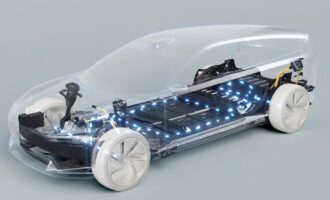
Bosch introduces CVT concept for electric vehicles
Bosch Transmission Technology B.V., a Dutch subsidiary of Germany’s Robert Bosch GmbH, has introduced the concept of a continuously variable automatic transmission (CVT) for electric vehicles to solve one of the challenges for the electrical powertrain. Based in Tilburg, the company is a leader in the development of and mass production of CVT push belts.
Currently, almost all electric cars have only one forward gear, but when tackling steep ascents with a heavy load on board or driving longer freeway stretches at high speed, the battery charge drops rapidly. In such situations, a multi-stage transmission can work more efficiently.
To demonstrate this, Bosch installed a CVT with push belt in a test vehicle. Called CVT4EV, this transmission increases efficiency by up to 4%. Depending on design, this can provide more torque in traction mode, better acceleration, or a higher maximum speed.
“The CVT4EV expands the electrical car’s repertoire,” says Gert-Jan van Spijk, who is in charge of CVT engineering at Bosch. And because the transmission adjusts the ratio continuously without loss of traction, the driving ease typical of e-vehicles is not lost.
Better performance, lower energy consumption
The CVT4EV’s variable gear ratio provides the best possible balance of efficiency and performance, according to Bosch. The system can freely control the speed and torque of the electric motor. At low speeds, a smaller gear ratio improves acceleration and handling characteristics on ascents, while a higher ratio enhances efficiency at higher speeds, as well as increasing top speed. In addition, it provides increased torque when towing and driving offroad, yet with lower energy consumption.
Especially at constant speeds, the CVT4EV reduces the vehicle’s energy requirements. Due to the electric motor’s reduced torque and speed requirements, a cheaper and more compact motor can deliver the same or even better performance. Alternatively, the same motor can achieve a greater range. As a result, manufacturers of electric vehicles can find the optimum balance between battery capacity and range.
This powertrain solution consists of a CVT4EV module, an inverter, an electric motor, and an axle drive with a ratio adapted to the vehicle. It is suitable for a wide variety of applications, from midsize cars to sports cars to light commercial vehicles. Since individual software programs can often adapt the powertrains to the respective area of application, fewer hardware variants are needed. This cuts costs in both development and production.









